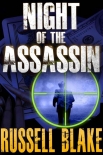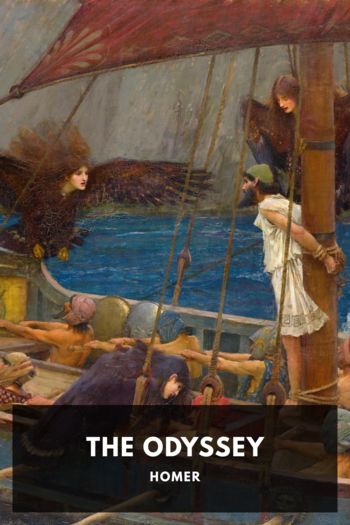The Gangster, Clive Cussler [ebook smartphone txt] 📗

- Author: Clive Cussler
Book online «The Gangster, Clive Cussler [ebook smartphone txt] 📗». Author Clive Cussler
The platform was empty.
He looked up. Branco had climbed onto the roof.
Grabbing ironwork, Edwards jumped onto a hand-brake wheel, muscled his way up between the front of the baggage car and the tender, and hauled himself onto the sloping end of the roof.
The roof was empty.
He whirled his head, thinking Branco was on the tender about to smash him with a lump of coal. But the tender was empty, too. He looked down at the empty blind. Where had the gangster gone? Only one place. Off the train. He must have jumped out the other side of the blind, back into a yard full of rail cops and angry detectives.
Antonio Branco climbed a slope out of the Jersey Central rail yards into a neighborhood condemned by the ever-expanding railroad and raced across town through dark streets of boarded-up tenements. Of the four lines he had seen leaving the city, there was one to the north of the Queen of the Valley’s Harrisburg line. It was the Scranton line—the line he had wanted all along but did not want the Van Dorns to know he was riding. When he reached it—down an embankment and over a fence—he looked for the train he had chosen earlier.
Sorriso di Dio! Fortune smiled. There—the distinctive humped silhouette of the camelback center-cab 2-6-0 locomotive. The fast freight was made up and rolling, shunting out of the yard. He ran ahead, along the main line. The beam of its headlight threw shadows from his heels. He dove into the shallow trench beside the tracks and hid. The engine thundered past, straining to accelerate, in clouds of smoke and steam.
Branco sprang into the cloud and galloped beside the moving train. The reefer cars would be full, doors locked. Empty coal hoppers were deadly in the cold wind. Looking over his shoulder, he spied a flatcar on which a steam shovel was chained like a captive. He slowed to let the car overtake him and jumped aboard.
Nurses lingered.
“Handsome devil.”
“What do you suppose he’s thinking?”
“What makes you think he’s thinking at all . . . ?”
Physicians argued.
“Coma—”
“I say stupor.”
“Coma: laceration of the brain; capillary hemorrhage; lesion.”
“The brain is a tissue. It has a capacity for healing.”
“Lividity of the tongue and lips. Embarrassed respiration.”
“Swallowing—impossible in coma . . . Toxemia?”
“Lesion.”
A younger doctor weighed in, short on experience, long on science. “The patient’s head is not turned. His eyes are not deflected to either side. If there was a lesion, the patient would look toward it. There is no lesion.”
“Then what?”
“Asphyxia.”
The moon hovered inside a silver halo. Full and perfectly round.
It was beautiful and distant, and then it slipped away.
The dark came back. It settled in heavily again, deep as winter.
27
Antonio Branco’s fast freight to eastern Pennsylvania was sidelined to let the Lackawanna Railroad’s “Phoebe Snow” passenger sleeper overtake. He jumped off the flatcar and climbed under it. Before the Phoebe Snow highballed past, he had found a safer and slightly warmer place on the rods.
He stuck with the train until the Bethlehem Junction yards, where he dodged a yard bull and climbed under a freight to Wilkes-Barre. At Wilkes-Barre, he caught a train to Scranton, riding on the roof, when he saw brakemen checking the rods. He clung to a ventilator and kept a close eye on the tracks ahead of the locomotive so he wouldn’t be lurched off by a sharp curve, jumped when it slowed approaching the yards, found a barn a mile from the tracks, and slept in the hayloft. After dark, he climbed under a Delaware & Hudson coal train that turned slowly northeastward through Carbondale to Cadosia, where the coal hoppers were switched to the southeastwardly bearing New York, Ontario & Western Railway. He rode them at a glacial pace, night and day and night again, through Summitville, Middletown, and Maybrook.
After Meadowbrook, he smelled tidewater.
The first gray light of dawn revealed that the tracks squeezed between steep hills and the Hudson River, deep in mist. Estates appeared on the hillsides, Gothic, Greek Revival, and old American-style mansions set far apart on lawns as big as farms. An enormous summer tourist hotel loomed up unexpectedly, then a three-story icehouse with a wharf to barge the ice harvest to New York, then white boardinghouses, and, quite suddenly, redbrick factories.
He heard the locomotive back off and felt the heavy cars butt couplers. When he glimpsed a huge jetty surrounded by steamers, he flexed his stiff knee to get ready to run. The train slowed for its final stop, the Cornwall Landing coal docks at the foot of Storm King Mountain.
Filthy, hungry, and frozen to the bone, Antonio Branco had traveled five hundred miles in a circle that landed him—without a trace of where he had come from—just fifty miles north of where he had ditched the Van Dorns in Jersey City. No one knew he was there. No one knew where he came from—just another Italian pick and shovel man begging to work on the Catskill Aqueduct for a dollar seventy-five cents a day.
As the coal train entered the yards, the morning sun cleared a hill on the far side of the river and cast yellow light on a huge estate house that reminded Branco of Greek ruins in Sicily. He recognized John Butler Culp’s famous Raven’s Eyrie. He had seen it often from the Hudson River steamboats—long before he learned that Culp was his man.
But what riveted his attention was the sight of Culp’s private train. It was waiting in the Cornwall Landing rail yards—splendid red coaches drawn by an ink-black Atlantic 4-4-2.
The locomotive had steam up.
Culp could leave at a moment’s notice.
Branco had no time to lose.
He jumped from the rods before the train stopped rolling and





Comments (0)